The RNA-binding protein KSRP aggravates malignant progression of clear cell renal cell carcinoma through transcriptional inhibition and post-transcriptional destabilization of the NEDD4L ubiquitin ligase
- PMID: 37580757
- PMCID: PMC10424398
- DOI: 10.1186/s12929-023-00949-9
The RNA-binding protein KSRP aggravates malignant progression of clear cell renal cell carcinoma through transcriptional inhibition and post-transcriptional destabilization of the NEDD4L ubiquitin ligase
Abstract
Background: KH-type splicing regulatory protein (KHSRP, also called KSRP), a versatile RNA-binding protein, plays a critical role in various physiological and pathological conditions through modulating gene expressions at multiple levels. However, the role of KSRP in clear cell renal cell carcinoma (ccRCC) remains poorly understood.
Methods: KSRP expression was detected by a ccRCC tissue microarray and evaluated by an in silico analysis. Cell loss-of-function and gain-of-function, colony-formation, anoikis, and transwell assays, and an orthotopic bioluminescent xenograft model were conducted to determine the functional role of KRSP in ccRCC progression. Micro (mi)RNA and complementary (c)DNA microarrays were used to identify downstream targets of KSRP. Western blotting, quantitative real-time polymerase chain reaction, and promoter- and 3-untranslated region (3'UTR)-luciferase reporter assays were employed to validate the underlying mechanisms of KSRP which aggravate progression of ccRCC.
Results: Our results showed that dysregulated high levels of KSRP were correlated with advanced clinical stages, larger tumor sizes, recurrence, and poor prognoses of ccRCC. Neural precursor cell-expressed developmentally downregulated 4 like (NEDD4L) was identified as a novel target of KSRP, which can reverse the protumorigenic and prometastatic characteristics as well as epithelial-mesenchymal transition (EMT) promotion by KSRP in vitro and in vivo. Molecular studies revealed that KSRP can decrease NEDD4L messenger (m)RNA stability via inducing mir-629-5p upregulation and directly targeting the AU-rich elements (AREs) of the 3'UTR. Moreover, KSRP was shown to transcriptionally suppress NEDD4L via inducing the transcriptional repressor, Wilm's tumor 1 (WT1). In the clinic, ccRCC samples revealed a positive correlation between KSRP and mesenchymal-related genes, and patients expressing high KSRP and low NEDD4L had the worst prognoses.
Conclusion: The current findings unveil novel mechanisms of KSRP which promote malignant progression of ccRCC through transcriptional inhibition and post-transcriptional destabilization of NEDD4L transcripts. Targeting KSRP and its pathways may be a novel pharmaceutical intervention for ccRCC.
Keywords: EMT; KSRP; NEDD4L; Progression; ccRCC.
© 2023. National Science Council of the Republic of China (Taiwan).
Conflict of interest statement
The authors declare that no competing interests exist.
Figures

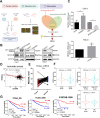
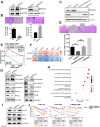
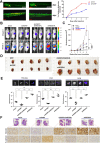
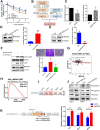
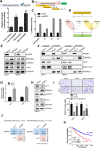

Similar articles
-
miR-9-5p/HMMR regulates the tumorigenesis and progression of clear cell renal cell carcinoma through EMT and JAK1/STAT1 signaling pathway.J Transl Med. 2025 Jan 9;23(1):36. doi: 10.1186/s12967-024-05988-w. J Transl Med. 2025. PMID: 39789627 Free PMC article.
-
NEDD4L Suppresses Proliferation and Promotes Apoptosis by Ubiquitinating RAC2 Expression and Acts as a Prognostic Biomarker in Clear Cell Renal Cell Carcinoma.Int J Mol Sci. 2024 Nov 6;25(22):11933. doi: 10.3390/ijms252211933. Int J Mol Sci. 2024. PMID: 39596003 Free PMC article.
-
Preclinical studies using miR-32-5p to suppress clear cell renal cell carcinoma metastasis via altering the miR-32-5p/TR4/HGF/Met signaling.Int J Cancer. 2018 Jul 1;143(1):100-112. doi: 10.1002/ijc.31289. Epub 2018 Apr 2. Int J Cancer. 2018. PMID: 29396852 Free PMC article.
-
Roles of K(H)SRP in modulating gene transcription throughout cancer progression: Insights from cellular studies to clinical perspectives.Biochim Biophys Acta Rev Cancer. 2024 Nov;1879(6):189202. doi: 10.1016/j.bbcan.2024.189202. Epub 2024 Oct 22. Biochim Biophys Acta Rev Cancer. 2024. PMID: 39447687 Review.
-
The role of KSRP in mRNA decay and microRNA precursor maturation.Wiley Interdiscip Rev RNA. 2010 Sep-Oct;1(2):230-9. doi: 10.1002/wrna.2. Epub 2010 May 6. Wiley Interdiscip Rev RNA. 2010. PMID: 21935887 Review.
Cited by
-
Ubiquitin-specific protease 1 facilitates hepatocellular carcinoma progression by modulating mitochondrial fission and metabolic reprogramming via cyclin-dependent kinase 5 stabilization.Cell Death Differ. 2024 Sep;31(9):1202-1218. doi: 10.1038/s41418-024-01342-1. Epub 2024 Jul 15. Cell Death Differ. 2024. PMID: 39009653 Free PMC article.
-
irCLIP-RNP and Re-CLIP reveal patterns of dynamic protein assemblies on RNA.Nature. 2025 May;641(8063):769-778. doi: 10.1038/s41586-025-08787-5. Epub 2025 Mar 26. Nature. 2025. PMID: 40140581
-
The role of RNA binding proteins in cancer biology: A focus on FMRP.Genes Dis. 2024 Dec 21;12(4):101493. doi: 10.1016/j.gendis.2024.101493. eCollection 2025 Jul. Genes Dis. 2024. PMID: 40271197 Free PMC article. Review.
-
NEDD4L in human tumors: regulatory mechanisms and dual effects on anti-tumor and pro-tumor.Front Pharmacol. 2023 Nov 9;14:1291773. doi: 10.3389/fphar.2023.1291773. eCollection 2023. Front Pharmacol. 2023. PMID: 38027016 Free PMC article. Review.
-
Identification of RNA-binding protein genes associated with renal rejection and graft survival.Ren Fail. 2024 Dec;46(2):2360173. doi: 10.1080/0886022X.2024.2360173. Epub 2024 Jun 14. Ren Fail. 2024. PMID: 38874084 Free PMC article.
References
MeSH terms
Substances
Grants and funding
LinkOut - more resources
Full Text Sources
Medical
Molecular Biology Databases

